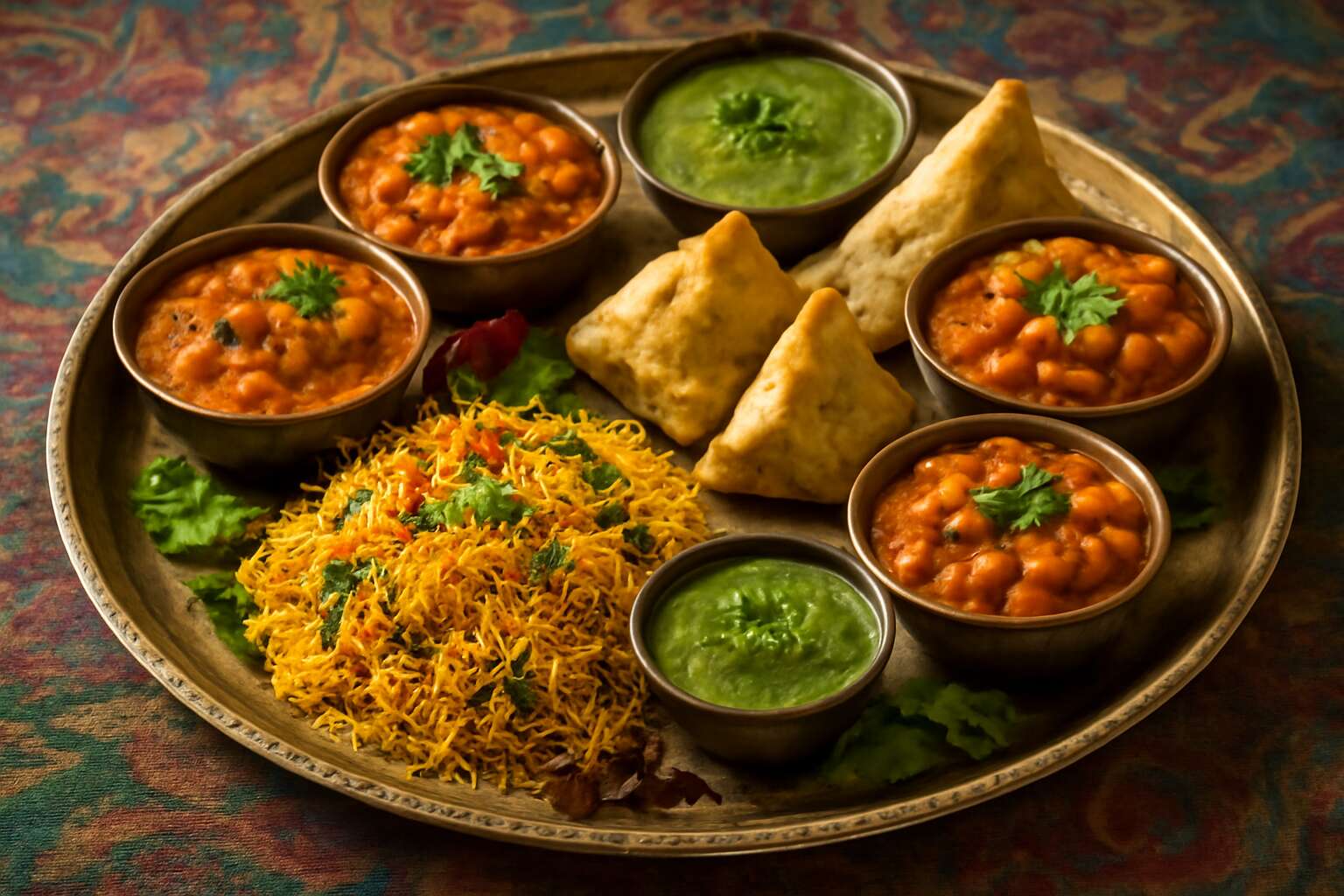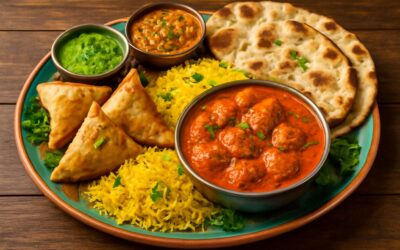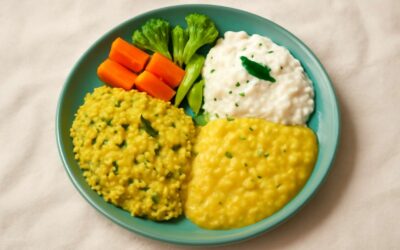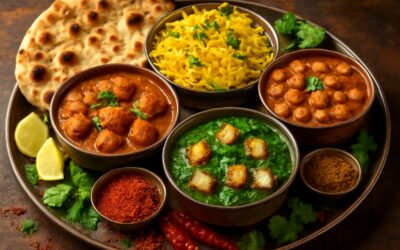Popular Traditional Indian Dishes
Biryani – Origins, varieties, and cultural significance
In the shadowed corridors of culinary history, few dishes evoke the mystique and grandeur of Biryani — a cornerstone of traditional Indian food famous across the subcontinent. Its origins trace back centuries to the royal kitchens of Mughal emperors, where fragrant spices and tender meats were woven into a tapestry of flavor that transcends time. Each grain of Biryani whispers stories of opulence and cultural fusion, embodying the soul of Indian tradition.
Today, the varieties of Biryani are as diverse as the regions that cherish it. From the fiery Hyderabadi to the aromatic Kolkata style, each rendition is a testament to local heritage. The cultural significance of Biryani lies not only in its rich aroma and complex taste but also in its role as a communal feast, binding families and communities together in celebration.
- Hyderabadi Biryani
- Kolkata Biryani
- Lucknowi (Awadhi) Biryani
As a quintessential example of traditional Indian food famous for its deep roots and vibrant flavors, Biryani continues to enchant palates worldwide, a mysterious delight rooted in history’s dark and fragrant corridors.
Butter Chicken – Preparation methods and regional influences
In the grand tapestry of traditional Indian food famous across the subcontinent, Butter Chicken stands out as a celestial symphony of flavors—rich, velvety, and irresistibly aromatic. Originating from the vibrant kitchens of Delhi, this dish embodies the perfect harmony between tender, marinated chicken and a luxurious tomato-based gravy, infused with a melange of spices and cream. Its preparation method is an art form, where chicken is first marinated in yogurt and spices, then slow-cooked to tender perfection, ensuring each bite melts in the mouth like a warm embrace.
Regional influences breathe life into Butter Chicken, with North Indian kitchens adding a distinctive tandoori smoky essence while southern variations incorporate coconut milk for a subtle sweetness. The culinary process often involves simmering the chicken in a blend of tomatoes, garlic, ginger, and butter—transforming humble ingredients into a dish of opulent grandeur. This dish’s popularity is not merely due to its flavor but also because of its role in uniting families and communities around a shared table of celebration and comfort.
Masala Dosa – Ingredients, variations, and serving tips
Among the vast spectrum of traditional Indian food famous for its vibrant flavors and cultural significance, Masala Dosa stands out as a beloved staple that captures the essence of South Indian cuisine. This crispy, golden pancake made from fermented rice and urad dal batter is not just a breakfast dish but a culinary experience that embodies centuries of tradition. The filling, typically a spicy potato masala seasoned with mustard seeds, turmeric, and curry leaves, adds a hearty, comforting dimension that appeals to both locals and explorers of Indian cuisine.
Variations of Masala Dosa are as diverse as India itself. Some regions add a tangy coconut chutney or sambar, a spicy lentil stew, to elevate the dish further. Serving tips often include accompanying the dosa with a medley of chutneys—coconut, tomato, or mint—each offering a unique burst of flavor. The art of preparing this dish hinges on achieving the perfect balance between the crispness of the dosa and the softness of the filling, making every bite a delight that transports you to India’s bustling streets.
Paneer Tikka – Cooking techniques and occasions
Paneer Tikka exemplifies the rich tapestry of traditional Indian food famous for its bold flavors and vibrant ingredients. This vegetarian delight is crafted through a meticulous marination process, where chunks of paneer are coated in a mixture of yogurt, spices, and herbs. The technique involves skewering the marinated paneer and grilling it to perfection, resulting in a smoky aroma and a slightly charred exterior that contrasts beautifully with the soft, flavorful interior.
Typically served during festive occasions or communal gatherings, Paneer Tikka is a crowd favorite because of its versatility and satisfying taste. The dish often accompanies an array of chutneys—mint, coriander, or tangy tamarind—that enhance its complexity and provide a delightful burst of flavor. Its popularity is rooted in the way it embodies the essence of traditional Indian food famous for its rich, aromatic profile.
For those seeking an authentic experience, mastering the grilling technique is crucial, as it imparts the signature smoky flavor that sets this dish apart. Whether prepared in a tandoor or a modern grill, Paneer Tikka remains a quintessential example of India’s culinary artistry, celebrated for its simplicity and depth of flavor.
Rogan Josh – Historical background and taste profile
Rogan Josh isn’t just a dish; it’s a culinary legend that whispers tales of centuries gone by. Originating from the royal kitchens of Kashmir, this traditional Indian food famous for its rich, aromatic gravy has become a staple in Indian cuisine. The vibrant red hue comes from a blend of spices and saffron, creating a visual feast that promises a symphony of flavors with every bite.
What sets Rogan Josh apart is its complex taste profile—spicy, savory, with subtle hints of sweetness and earthiness. The tender lamb or goat meat absorbs the spices beautifully, making each serving a memorable experience. This dish’s historical background is steeped in Mughal influence, where Persian culinary techniques fused with Indian ingredients, resulting in a dish that is both regal and rustic. For those craving an authentic taste of Indian tradition, Rogan Josh epitomizes the essence of traditional Indian food famous for its depth and heritage.
Regional Indian Cuisines Known for Their Traditional Foods
North Indian Cuisine – Staples, flavors, and iconic dishes
North Indian cuisine embodies a rich tapestry of flavors, textures, and culinary traditions that have stood the test of time. It is renowned for its hearty staples such as naan, roti, and fragrant pilafs, which serve as the backbone of many meals. Each dish is a reflection of centuries-old recipes passed down through generations, blending local spices with regional influences. The iconic dishes—like creamy curries, tender kebabs, and spiced lentils—are celebrated worldwide for their depth and complexity.
What makes North Indian food truly remarkable is its ability to balance bold flavors with subtle nuances. The use of garam masala, cumin, coriander, and saffron creates a symphony of taste that is both comforting and invigorating. This culinary tradition is famous for its versatility, accommodating various dietary preferences and occasions. Whether served at grand celebrations or simple family dinners, traditional Indian food famous in North India continues to captivate those seeking authentic, soul-satisfying cuisine.
South Indian Cuisine – Distinct ingredients and popular dishes
South Indian cuisine, a symphony of vibrant flavors and aromatic ingredients, beckons with a promise of culinary artistry rooted deep in tradition. Known for its distinct use of rice, coconut, and tamarind, this traditional Indian food famous for its unique taste profile offers a sensory journey unlike any other. The region’s dishes are often characterized by their gentle spice and profound subtlety, creating a delicate balance that captivates both purists and curious palates alike.
Among its most beloved offerings are the crispy, golden masala dosas filled with spiced potatoes, served with tangy chutneys. The hearty idlis and dosa varieties are staples, crafted with fermented rice and lentils, embodying centuries of culinary evolution. Not to be missed are the flavorful sambar and an array of coconut-based chutneys, which elevate each bite to a celebration of regional ingredients.
What truly sets South Indian cuisine apart is its emphasis on natural ingredients and a meticulous cooking process that preserves purity and authenticity. Dishes like filter coffee and banana chips add a touch of everyday elegance, making this traditional indian food famous not only for its taste but for its cultural richness. It’s a cuisine that dances on the palate, offering both comfort and a burst of invigorating freshness, a true testament to the culinary mastery of South India.
Punjabi Cuisine – Rich, hearty foods and signature recipes
Punjabi cuisine stands tall among the many regional Indian cuisines, celebrated for its hearty, soul-satisfying dishes that pack a punch of flavor. It’s the kind of food that makes you forget all your worries—if only for a meal! Known for its generous use of dairy, spices, and robust ingredients, traditional Indian food famous in Punjab is a testament to culinary indulgence. From velvety butter chicken to sizzling tandoori delicacies, the region’s signature recipes have a way of warming both the heart and the palate.
What makes Punjabi cuisine truly stand out is its emphasis on communal eating and rustic flavors. Popular dishes include:
- Amritsari Fish—crispy, tangy, and perfect with a squeeze of lemon
- Chole Bhature—a spicy chickpea curry paired with fluffy fried bread
- Saag Paneer—creamy spinach with melt-in-your-mouth cheese
These dishes aren’t just food; they’re a cultural experience, embodying the exuberance and tradition of Punjab. When it comes to traditional Indian food famous for comfort and richness, Punjabi cuisine remains an unbeatable favorite—an aromatic celebration of Indian culinary artistry that continues to delight food lovers worldwide.
Gujarati Cuisine – Vegetarian specialties and unique flavors
Gujarati cuisine stands as a testament to India’s rich culinary diversity, celebrated for its vibrant vegetarian specialties and unique flavor combinations. In a world increasingly craving plant-based options, Gujarati food exemplifies how wholesome ingredients can create extraordinary tastes. This regional cuisine is characterized by its complex blend of sweet, sour, and spicy notes—each dish telling a story of cultural resilience and culinary ingenuity.
What truly sets Gujarati traditional Indian food famous is its inventive use of spices and ingredients, often resulting in dishes that are both comforting and invigorating. From the tangy sweetness of Gujarati dal to the crispy, sesame-coated Thepla, each bite offers a glimpse into the region’s deep-rooted food traditions. The cuisine’s emphasis on vegetarian dishes makes it a wholesome choice, appealing to a broad spectrum of dietary preferences.
Popular dishes include:
- Undhiyu – a slow-cooked vegetable medley with a hint of sweetness
- Khaman Dhokla – fluffy, fermented gram flour snack bursting with flavors
- Fafda-Jalebi – a perfect sweet and savory combination enjoyed during festivals
These recipes showcase the artistry behind Gujarati food—a harmonious balance of flavors that elevates vegetarian cuisine to an art form. For those seeking traditional Indian food famous for its distinctive taste and cultural depth, Gujarati cuisine remains an unmissable culinary experience—an authentic journey into India’s soul through its vegetarian delicacies.
Maharashtrian Cuisine – Spicy, flavorful offerings
In the vibrant mosaic of Indian culinary traditions, Maharashtrian cuisine shines as a captivating tapestry woven with bold spices and fiery flavors. Known for its robust and spicy offerings, this regional cuisine embodies the spirit of Maharashtra—passionate, hearty, and full of life. From the smoky aroma of *misal pav* to the tangy zest of *puran poli*, each dish narrates a story of cultural resilience and culinary mastery.
Maharashtrian food’s distinctive character is rooted in its ingenious use of ingredients—dried coconut, jaggery, and an array of pungent spices—that create complex layers of taste. Its signature dishes often feature a delightful balance of heat and sweetness, exemplified by dishes like Vada Pav, a street food icon that encapsulates the essence of the region’s vibrant street food scene. The cuisine’s popularity is further cemented by its flavorful, wholesome offerings such as Kolhapuri chicken and Thalipeeth.
- Vada Pav—The quintessential spicy potato fritter sandwiched in a soft bread roll, often accompanied by fiery chutneys.
- Puran Poli—Sweet, stuffed flatbread infused with jaggery and cardamom, offering a comforting yet invigorating taste experience.
- Misal Pav—A spicy sprouted bean curry topped with farsan and served with bread, perfect for those craving bold flavors.
These dishes exemplify how Maharashtrian cuisine is a celebration of fiery, authentic flavors—making it one of the most traditional indian food famous for its irresistible spice and cultural depth. Each plate invites a sensory journey into Maharashtra’s vibrant food heritage, where every bite pulses with history and passion.
Cultural Significance of Indian Food
Festive Celebrations – Traditional dishes for festivals like Diwali, Holi
In the vibrant tapestry of Indian culture, food is more than sustenance; it’s a language of celebration and heritage. During festivals like Diwali and Holi, traditional Indian food takes center stage, transforming humble ingredients into symbols of prosperity, joy, and unity. These festive dishes are imbued with centuries-old stories, often passed down through generations, making every bite a journey into India’s rich cultural history.
For instance, Diwali’s signature sweets such as Gulab Jamun and Kaju Katli are not merely desserts but carry spiritual significance, representing sweetness and prosperity. Meanwhile, Holi’s riotous colors are complemented by spicy, aromatic treats like Gujiya and Thandai, which embody the exuberance of spring. These dishes serve as edible expressions of India’s diverse regional influences, from the North’s rich gravies to the South’s coconut-infused delicacies.
- Festive feasts often feature traditional Indian food famous for its intricate flavors and cultural symbolism.
- They foster communal bonds, turning meals into vibrant celebrations that transcend mere nourishment.
In essence, these culinary traditions are an integral part of India’s identity, turning every festival into a grand gastronomic affair that is as meaningful as it is delicious.
Religious Traditions – Vegetarianism, fasting foods, and rituals
Indian cuisine is a tapestry woven with spiritual reverence and age-old rituals, where food transcends mere sustenance to become a sacred act rooted in centuries of tradition. Religious customs often dictate dietary choices, with vegetarianism standing as a pillar for many communities, symbolizing purity and devotion. Fasting foods, imbued with spiritual significance, are prepared with meticulous care, transforming simple ingredients into offerings that honor divine presence. During auspicious festivals and rituals, specific dishes are crafted to embody blessings and prosperity, turning every meal into an act of reverence.
For example, traditional Indian food famous for its ritualistic importance often includes dishes like Khichdi, a humble yet revered comfort food, and Pooja sweets such as Ladoo and Halwa, which are integral to spiritual ceremonies. These foods are not only nourishing but also serve as a bridge connecting devotees to their spiritual heritage. The intricate layers of flavor and symbolism in these dishes forge a profound link between culinary artistry and cultural identity, making Indian cuisine a divine celebration of faith and tradition.
Weddings and Special Occasions – Feasts and ceremonial foods
In Indian culture, food is much more than just nourishment; it’s a profound expression of identity and community. During weddings and special occasions, traditional Indian food takes center stage, transforming every celebration into a vibrant feast that reflects cultural richness. These events often feature ceremonial foods that symbolize prosperity, unity, and blessings, making them an essential part of the festivities.
For example, grand wedding feasts showcase dishes like aromatic Biryani, spicy Rogan Josh, and sweet treats such as Gulab Jamun and Kheer. These foods are carefully prepared to honor tradition and convey good wishes. The significance of these dishes extends beyond taste—they serve as a cultural bridge, connecting generations through shared flavors and customs. Such culinary traditions highlight how Indian cuisine, famous for its intricate flavors and symbolism, plays a pivotal role in celebrating life’s milestones with grandeur and reverence.
Ingredients and Spices Typical of Indian Cooking
Essential Spices – Cumin, coriander, turmeric, garam masala
Indian cuisine’s allure lies not only in its vibrant tapestry of flavors but also in its masterful use of ingredients and spices that have captivated palates worldwide. The hallmark of traditional Indian food famous for its depth and complexity is undoubtedly the meticulous blend of spices—each with a story and a purpose. Cumin, coriander, turmeric, and garam masala form the core of many recipes, transforming simple ingredients into culinary masterpieces.
Cumin seeds lend an earthy warmth that enhances the aroma of curries, while coriander adds a citrusy brightness that balances rich sauces. Turmeric, with its vibrant golden hue, imparts both color and a subtle bitterness, symbolizing health and vitality in Indian cooking. Garam masala, a fragrant spice blend, unifies these elements with a smoky, spicy undertone that elevates every dish it touches.
For those seeking to explore the essence of traditional Indian food famous across regions, understanding these essential spices is crucial. Often, they are combined in an ordered manner—such as in an
- initial tempering of cumin and coriander seeds
- followed by the addition of turmeric, garlic, and ginger
- culminating in the sprinkling of garam masala to finish the dish
. This layered approach to spice blending exemplifies Indian culinary artistry—each step building on the last, creating a symphony of flavors that define the cuisine’s enduring appeal.
Herbs and Condiments – Cilantro, mint, coconut
Indian cuisine’s vibrant palette is as much about its herbs and condiments as it is about its spices. When exploring traditional Indian food famous across regions, herbs like cilantro and mint are indispensable for their fresh, aromatic qualities. Cilantro, with its bright, citrusy notes, often crowns curries and chutneys, adding a burst of freshness that balances rich, savory flavors. Mint, on the other hand, lends a cooling contrast, especially in summer drinks or yogurt-based dishes like raita.
Another ingredient that holds a special place in Indian kitchens is coconut. Its versatility spans from shredded coconut in South Indian dishes to coconut milk used to create creamy curries and desserts. The natural sweetness and subtle richness of coconut elevate the complexity of traditional Indian food famous in coastal regions and beyond. These herbs and condiments—cilantro, mint, and coconut—embody the essence of Indian culinary artistry, transforming simple ingredients into a celebration of flavors.
Staple Ingredients – Lentils, rice, chickpeas, vegetables
Indian cuisine is a tapestry woven with a rich array of ingredients that make every dish a flavor-packed adventure. At the heart of traditional Indian food famous across regions are staples like lentils, rice, chickpeas, and fresh vegetables. These ingredients form the backbone of countless iconic dishes, from hearty dals to fragrant pilafs. Lentils, with their earthy aroma and comforting texture, are a must-have in dishes like dal tadka, bringing warmth and sustenance to the table.
Rice, another cornerstone, is celebrated in everything from fluffy basmati to sticky idlis. Chickpeas, known locally as chana, often star in spicy curries and snacks, embodying the bold, robust flavors Indian cuisine is renowned for. Vegetables—think eggplant, spinach, and cauliflower—are transformed into culinary masterpieces through traditional cooking techniques. For example, the classic saag or aloo gobi showcases how simple ingredients can be elevated into dishes that are both wholesome and incredibly flavorful.
- Turmeric, cumin, coriander, and garam masala—these spices are the secret weapons behind the vibrant taste profile of traditional Indian food famous for its layered complexity.
Whether it’s a comforting bowl of khichdi or a spicy sambar, these staple ingredients and spices encapsulate the essence of Indian culinary artistry, inviting everyone to experience its unparalleled richness.
Where to Experience Authentic Traditional Indian Food
Regional Restaurants – Places specializing in authentic cuisine
When craving authentic traditional Indian food famous for its rich flavors and vibrant spices, regional restaurants are the ultimate treasure trove. These culinary havens take you on a flavorful journey through India’s diverse tapestry, offering dishes that mirror local traditions and ingredients. From the aromatic curries of North India to the fiery, tangy delights of South Indian cuisine, each place promises an immersive experience that no food court can replicate.
For a truly authentic taste, seek out specialized establishments that focus solely on regional delicacies. Many cities boast gems such as Kashmiri eateries with their signature Rogan Josh, or Gujarati restaurants serving up the legendary Thali—an exquisite platter of vegetarian specialties. These restaurants often pride themselves on using traditional cooking techniques passed down through generations, ensuring every bite is a genuine reflection of Indian culinary heritage.
To deepen your exploration, consider visiting these types of places:
- Regional Indian restaurants that focus on North Indian classics like Butter Chicken and naan
- South Indian eateries renowned for Masala Dosa, idli, and sambar
- Punjabi dhabas serving hearty dishes like Sarson Ka Saag and Makki Ki Roti
Each of these spots offers a window into India’s culinary soul, making them perfect destinations for anyone eager to experience the true essence of traditional Indian food famous around the world.
Street Food Venues – Popular street foods and markets
In the vibrant tapestry of Indian culinary artistry, street food venues stand as bustling portals into the soul of traditional Indian food famous across the world. These markets, alive with the aroma of spices and sizzling grills, transform every visit into an immersive voyage. As you wander through crowded alleys or colorful bazaars, the sights, sounds, and smells converge into an intoxicating symphony of flavor.
From the fragrant stalls of Delhi’s Chandni Chowk to the lively lanes of Mumbai’s Crawford Market, each street corner offers a unique taste of India’s culinary heritage. You can savor crispy pav bhaji, tangy pani puri, or spicy vada pav—each a testament to India’s inventive street food culture. These venues often serve as culinary museums, revealing age-old recipes and techniques that have been passed down through generations.
Some of the most popular street food markets include:
- Old Delhi’s street food paradise, famous for chaat and kebabs
- Mumbai’s vibrant street stalls, renowned for vada pav and bhel puri
- Kolkata’s busy food markets, celebrated for kathi rolls and puchka
Exploring these lively street food venues offers a genuine portal into India’s rich culinary soul, where every bite tells a story and every flavor sparks a legend of tradition and innovation. Truly, these bustling markets are the heartbeat of the traditional Indian food famous for its bold spices, inventive snacks, and unmissable authenticity.
Cooking Classes – Learn to make traditional dishes
Experiencing the art of Indian cooking firsthand is an unforgettable journey into the heart of traditional Indian food famous worldwide. Cooking classes in India offer a rare chance to learn authentic techniques directly from seasoned chefs or local families. These immersive experiences reveal the secrets behind iconic dishes like butter chicken, masala dosa, and paneer tikka, allowing you to recreate their vibrant flavors at home.
Many culinary schools and community kitchens in cities such as Delhi, Mumbai, and Jaipur open their doors to eager learners. Participants often get hands-on experience with essential spices like cumin, turmeric, and garam masala, gaining insight into their roles in crafting complex flavors.
Some venues even organize guided visits to local spice markets or traditional farms, enriching your understanding of regional ingredients. Whether you’re a seasoned cook or a curious beginner, these classes are a gateway to truly appreciating the richness of India’s culinary heritage. After all, no other experience captures the essence of traditional Indian food famous quite like cooking alongside passionate local experts.




0 Comments